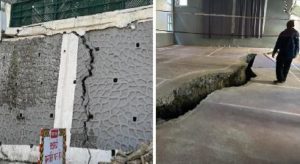
Joshimath, a small town in Uttarakhand that was built on the site of an ancient landslide, is situated in the foothills of the Himalayas and has experienced a rapid growth in both construction and population in recent years.
The city, which serves as Lord Badrinath’s winter residence, a staging area for troops stationed along the Sino-Indian border, and a sort of base camp for Himalayan expeditions, is in the news for the wrong reason right now: it is sinking.
Residents are protesting and expressing worry about the collapse of the town’s foundation. In order to prevent their homes from collapsing under their own weight, the residents claim that their houses have developed cracks and that they are compelled to find support structures. There are cracks in more than 500 homes in the area.
A recent survey by a team of experts confirmed what many locals had been fearing: the city is actually sinking at its base. According to Chief Minister Pushkar Singh Dhami, the circumstances in Joshimath are being closely watched. When it comes to this disaster waiting to happen in Joshimath, there is more to it than meets the eye.
Joshimath is a hilly town in Uttarakhand on the Rishikesh-Badrinath National Highway (NH-7). The city is a tourist destination because it serves as an overnight rest stop for visitors to Badrinath, Auli, Valley of Flowers, and Hemkund Sahib, among other important religious and tourist destinations in the state. Joshimath is also strategically important to the Indian military, as it is home to one of the Army’s most important cantonments.
The town is situated on a running ridge that is cut through by streams that descend steeply from Vishnuprayag, the point where the Dhauliganga and Alaknanda rivers converge. According to a report from 2022, there are numerous heavy layers of overburdened material covering the area near Joshimath.
While the Joshimath sinking crisis is currently making headlines, local geologists and scientists have been raising the alarm for decades. The first such report outlining the serious issue that might endanger life and property appeared in 1976. The government-appointed Mishra Commission’s report highlighted an important fact: Joshimath is situated on the site of an ancient landslide.
The town’s geography is the main factor contributing to Joshimath’s sinking. Experts have long warned that the landslide debris on which the city was built has a low bearing capacity and cannot support a high rate of construction. The slopes have become extremely unstable in the last few decades due to increased construction, hydroelectric projects, and the widening of the National Highway.
Other factors contributing to the fate of the city include erosion brought on by streams flowing from Vishnuprayag and sliding along natural streams. Old landslide debris including boulders, gneissic rocks, and loose soil has covered the area’s strewn rocks.
Researchers from the Wadia Institute of Himalayan Geology conducted a survey in 2022 and found that these gneissic rocks are highly weathered, have a low cohesive value, and have a propensity for high pore pressure when saturated with water, especially during monsoons.
In essence, the soil and land beneath Joshimath have a low capacity to hold together, especially when weighed down by additional construction.
“Seepage from streams uphill has been observed, which may have loosened the soil of Joshimath. The nalas disappear underground and arise overground downhill, bringing totally muddy water, and then join the Dhauliganga or the Alaknanda (beyond Vishnuprayag). The drainage system of the town of Joshimath is not well maintained. Waste water from the days’ usage flows through improper drains,” a 2006 report by Dr. Swapnamita Vaideswaran, Scientist, Wadia Institute of Himalayan Geology revealed.
“The nalas have been blocked by sludge that came from the 2013 Himalayan tsunami, which also facilitated the toe erosion in the region. The Rishiganga flood disaster also worsened the situation, followed by incessant rainfall between August to October in 2021. The problem had been long spreading,” Dr. Swapnamita told IndiaToday.in.
Experts advise that all construction and hydroelectric projects in the area be stopped immediately. The residents must first move to a safer area, and only then should the town’s planning be revised to account for the new variables and shifting geographical conditions.
One of the most important aspects that requires investigation and development is drainage planning. As more and more waste seeps into the soil, loosening it from within, the city is suffering from poor drainage and sewer management. The state government has requested that the irrigation department look into the situation and develop a new plan for the drainage system.
In order to preserve the soil capacity in the area, experts have also recommended replanting, particularly at the vulnerable sites. To save Joshimath, there needs to be a coordinated effort between the government and civil organisations with the help of military organisations like the BRO.




 Driving Naari Programme launched in Chandigarh
Driving Naari Programme launched in Chandigarh






























